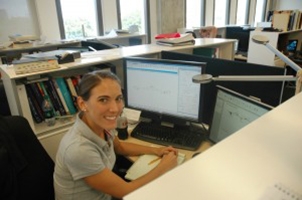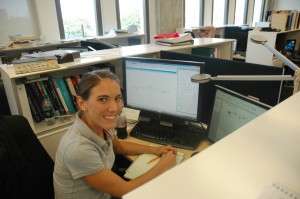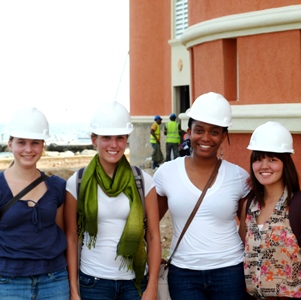
 For doctoral candidate Laura Redmond, the urge to become a civil engineer first nudged her in seventh grade, when an earthquake shook the foundation of her middle school.
For doctoral candidate Laura Redmond, the urge to become a civil engineer first nudged her in seventh grade, when an earthquake shook the foundation of her middle school.
“No one was hurt, but it was a 6.8 [magnitude] so we were all flat on the floor waiting for it to end,” says the Seattle native. “And I kept watching the carpet roll— literally like a wave – and I thought ‘this is crazy.’”
“Crazy” quickly became “captivated,” as Redmond was drawn to the challenge that earthquakes – and other catastrophic events – pose to the built world. She came to Georgia Tech as an undergraduate in 2007 to follow up on that challenge – and has never left.
“I like that Tech is really hands-on, that it puts a heavy emphasis on projects –more than I’ve seen at bigger schools,” she said. “It has given me the kind of experience I wanted.”
Backed by both a National Science Foundation (NSF) Graduate Research grant and an Achievement Rewards for College Scientists (ARCS) scholarship, Redmond’s doctoral research focuses on gauging the performance of hybrid concrete-masonry structures in the Caribbean. In most of that region the building stock has predominately been reinforced concrete frames with unreinforced masonry (URM) infill. “Unfortunately, lack of continuity between the frame and the masonry can cause the infill to fall out of plane during a seismic event and trigger soft-story collapses,” she said.
“Unfortunately, lack of continuity between the frame and the masonry can cause the infill to fall out of plane during a seismic event and trigger soft-story collapses,” she said.
Redmond observed this first hand when she visited the Caribbean with CEE Chair Dr. Reginald DesRoches as a part of the Caribbean Hazard Assessment Mitigation and Preparedness (CHAMP) team.
In her travels to Trinidad, Belize, Jamaica, and Peurto Rico, she saw that many engineers have begun to address this historic deficiency by tying the infill masonry into the structure with reinforcement to prevent this out-of-plane failure.
The resulting hybrid concrete masonry structures could ultimately be an attractive option for regions like the Caribbean, where earthquakes and hurricanes place competing demands on buildings.
“I interviewed civil engineers who really believed in using reinforced infill because it makes the walls less likely to fall out in a seismic event. But there is no established code for this type of structure— like there are for unreinforced infill structures –so designs are based on engineering judgment. More information is needed to make this a dependable, predictable method of building.”
For the last three years, Redmond has focused on amassing that information, a painstaking process that has involved finite element (FE) modeling. The results of this work can be used to study every component of the hybrid masonry, and, ultimately, to create tools that will account for the infill’s effect on the reinforced concrete frame. Those tools could also be used to design these types of structures in the future.
In addition to the Caribbean, Redmond's interest in this challenge led her to Turkey, where she learned more about FE modeling and testing of masonry infill structures with CEE alumnus Dr. Ozger Kurc at the Middle East Technical University. In the coming months, she will build a structure on the Georgia Tech campus with different types of reinforcements, which she will test to validate her models.
